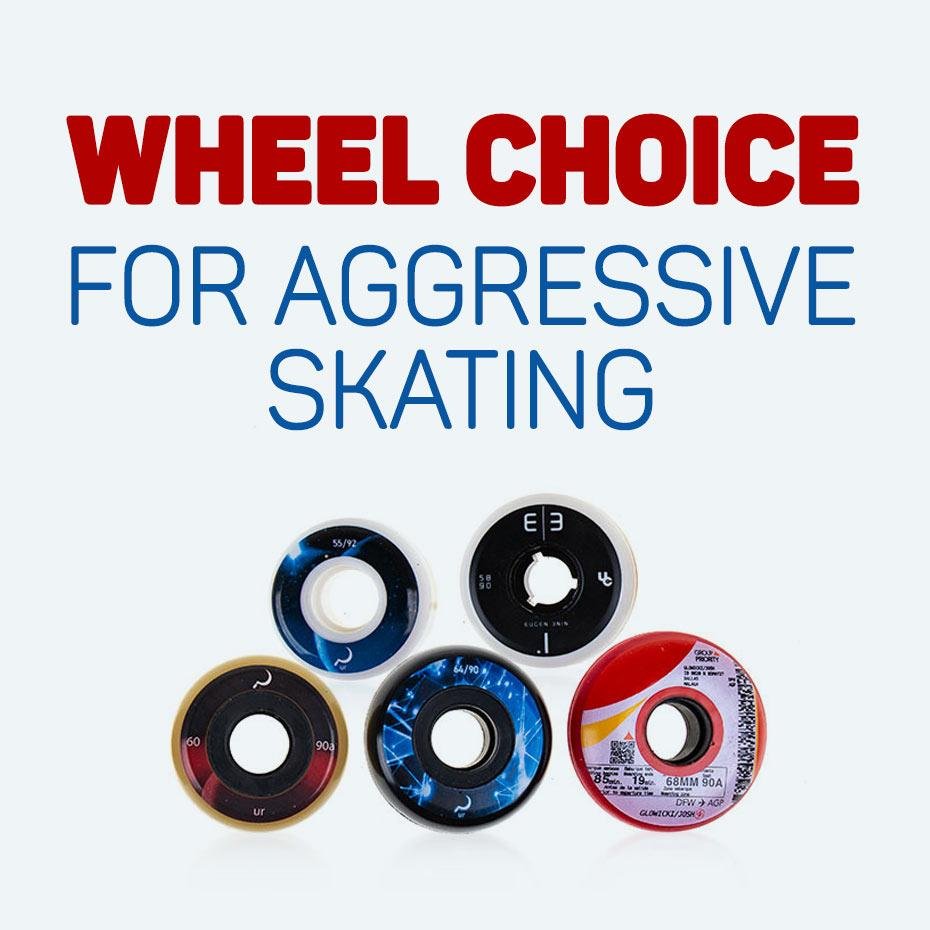Skaters' knowledge about the equipment has grown significantly during the last decade – thus, we can often meet people with customised setups, tailored to their needs. This applies to all advanced skating styles: freeskating, speed, downhill and of course, the grandfather of all - aggressive inline skating. Apart from newcomers, hardly anyone uses stock skates when it comes to the last one.
Replacing the liner, frames, anti-shock inserts or even the hardware itself (screws, washers) is nowadays basically a standard thing to do after buying a new pair of skates. Such approach allows for tuning the skate with selection of parts that correspond to a specific skating style, resulting in user having much more fun skating (and confidence in) their gear. Even tinkering with and tuning skates provides an intense amount of satisfaction by itself! Making a dream setup and going out for a first session with it feels almost magical.
You won't roll far without a good set of wheels.
Wheels are one of the key elements of aggressive skates. The number of available options can overwhelm even an advanced blader. There are few leading brands on the market and each of them offers several models of wheels, different in size, type of their cores, hardness, grip ...that's a lot of factors to take into account.
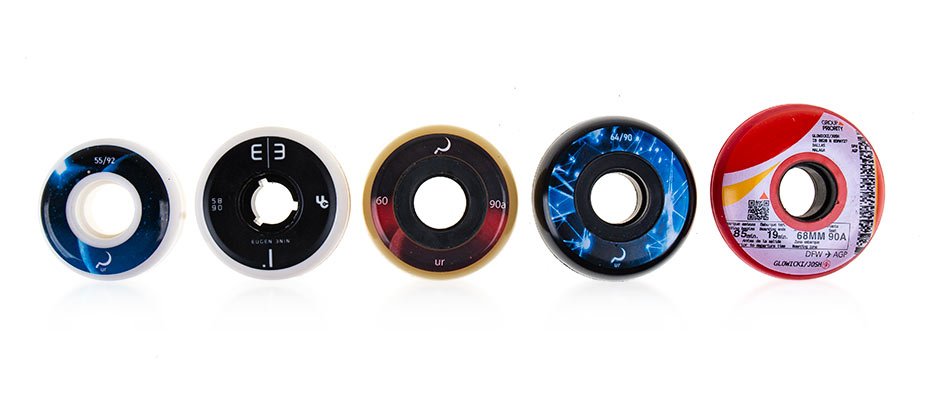
Size, hardness and shape are of great importance when skating aggressively - if you want to find out which wheels to choose for yourself, what features each model has and which of their properties can significantly improve your experience - read on.
The most common wheel setups in aggressive skating are:
FLAT Setup
Main characteristics of FLAT setup are:
- There are 4 regular wheels in one frame
- All 4 wheels are touching the ground when skate is placed on flat surface
Flat setups were very trendy between 2011-2015 and still have sworn fans, but are now again losing popularity to Anti-Rocker setups.
Four wheels in frame gives us mobility, stable landings and increased control over the skates. Personally, I would recommend this option to an absolute beginner (where skating alone may still be a problem, so good manoeuvrability will make learning the basics much easier), or to an experienced aggressive skater who has only ridden with anti-rocker so far and would like to have a fresh, completely unique experience bringing new challenges and possibilities.
While the FLAT setup can significantly broaden the horizons of inline skating, its most frequently mentioned disadvantage is the difficulty of performing H-block (frame groove) grinds - it can be troublesome. However, it is the right choice of wheels that can make the jump to FLAT a hundred times easier.
With FLAT setups, frames are of great importance - but this is a topic for a separate article - let's focus on what to pay attention to when choosing the wheels themselves.
Hardness
We start with the wheel hardness. Hard wheels make grinds easier, but greatly reduce the grip. When having 4 wheels in one frame, we recommend to "mix" their hardness and place them in the appropriate positions. The optimal and logical setting is to use soft wheels on the outside and hard on the inside. Skates will still grip to the ground, but even if we miss the correct grind stance - the middle, hard wheels should forgive such mistake, behaving more like standard grindhwheels (they will simply slide instead of sticking).
Size
If you are just starting to grind with eight wheels - we highly recommend ones with 54-58mm diameter. The levelof difficulty will be much lower. The larger wheels, the harder it will be to perform tricks - it is still possible, yet require much more skills. Thus, sizes 57-58 mm can be the gold standard, but if we want to make it even easier, use 54mm or 55mm wheels instead. Starting with this size, we will definitely not be discouraged from using FLAT setup.
Wheel profiles
The profile of the wheel is nothing more than its shape, i.e. how big contact area between wheel and surface is. Basically, we have 3 types of profiles:
- Full Profile wheels - low speed & manoeuvrability, high stability
- Semi Round Profile wheels - universal shape – good manoeuvrability, decent grip and speed
- Bullet / Speed Radius Wheels - high speed, low grip
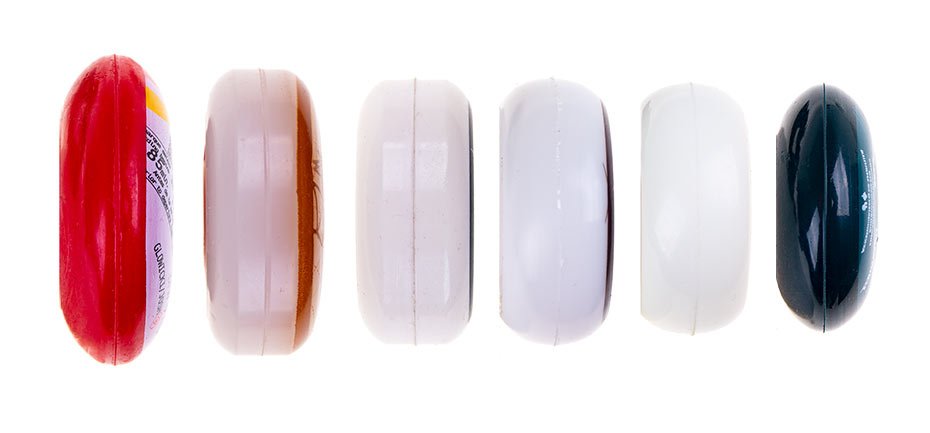
For riding FLAT, we strongly recommend the semi-round profile - we keep the key features of this setup (manoeuvrability and speed), and at the same time we feel stable on landings, as the contact area of wheel with the surface is still quite large.
Two examples of good FLAT setting wheels are Eulogy and Dead Wheels products. These are currently the only brands that offer smaller sizes of semi-round profile wheels. Furthermore, they deliver proven durability and optimal size.
It is worth to note that from time to time you can find frames using hybrid wheel setup, with bigger wheels on the outer and smaller inner position, with all of them still touching the ground at the same time. These frames are designed to provide a wider H-block groove to make wheelbite less of an issue. One of most succesful frames of this type is Oysi. Still, the general rules of choosing wheels are the same in this case: the size may be varied and it is best to use the setup recommended by manufacturer, but when it comes to hardness and profile, our tips are still valid.
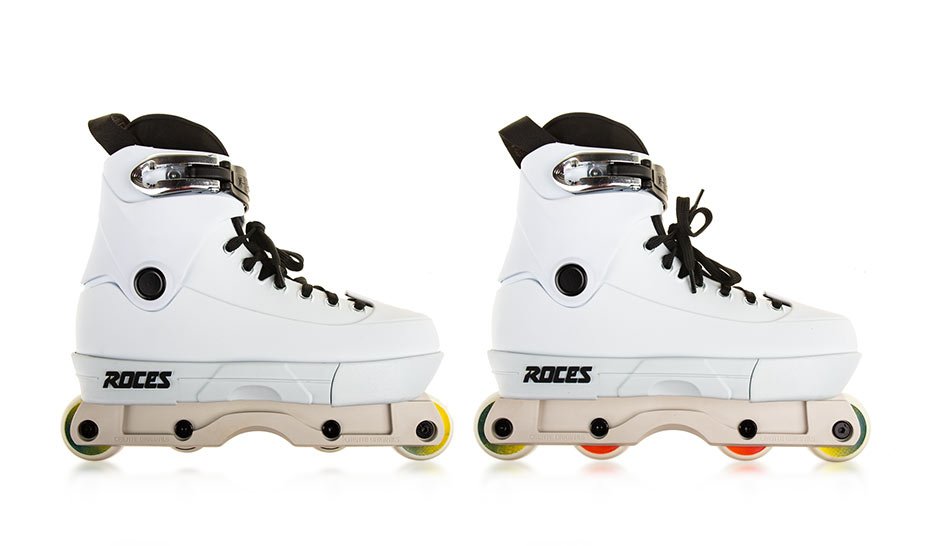
ANTI-ROCKER Setup
The rules are:
- Larger outer wheels (sizes 58mm-62mm)
- Only the outer wheels touches the surface
- Smaller and harder inner wheels (42mm-46mm, hardness 100-101a)
Anti-rocker is a popular and universal setting that has been used since the late 90's. Key feature of anti-rocker is making grinding rails and ledges easier, at the expense of significantly lowering skate mobility. This may be beneficial when riding fakie (backwards) into trick, as there's a bit of "on rails" feeling, making it easier to maintan skating course. In addition, such setup can noticeably reduce weight of the skate itself. Skating street with the anti-rocker setups (without a perfect riding surface, e.g. on cobblestones) is less smooth. Anti-rocker is also sacrificing speed. Jumping on a higher obstacles, such as a rails, will also require more effort.
Outer Wheels
When choosing the outer wheels for our anti-rocker setup, we have more freedom than in case of flat - we can pay attention to the features mentioned in the description of wheels for the latter, but the fact that we will not mix two types of wheels greatly simplifies the choice. We choose 1x set of external wheels on which we'll be rolling on and additionally, 1x set of hard grindwheels (which are not touching the ground at all during skating around).
We choose the outer wheels according to our preferences - if we need higher speed, we choose larger wheels (usually between 60mm-64mm). 99% of the available wheels with bigger sizes have semi-round or bullet profile. This gives optimal contact with the surface and decent grip, while maintaining manoeuvrability. Of course, quick turns and general mobility here will not be at the same level as in the FLAT setting, but you can still move relatively efficiently, if you have a good skating technique, that is.
Another choice are the full radius profile wheels - the contact area is the largest here, the wheels will be noticeably slower and skates will turn worse, but will be much more stable when landing bigger drops. Currently, the most common wheel sizes of this type are 55mm and 58mm. If you need increased stability, e.g. when approaching tricks from a fakie stance, this may be a good choice.
Personally, I use the anti-rocker setup in skateparks - transitions and playing around with technical grinds do not require super stability or additional support, and the perfect surfaces allow for maintaining optimal speed. In my case, I choose wheels with a metal core and relatively soft urethane - Undercover Apex 60mm 88A. The metal core in aggressive skating wheels is a kind of novelty; the wheels are super fast and it is much easier to maintain a decent energy transfer. But the key reason why I am using them, is because of their great grip.
Smooth skatepark surfaces are often very slippery, especially those made out of wood. With Apex wheels, there is no worry of any "slipping" - skating banks or quarter pipes is much easier. Apex wheels stick to the ground and give the impression of skating on an inflatable wheel.
Other wheels using metal core and softer urethane are Famus wheels, so you can consider picking them up as an alternative. Just a bit of warning - if you go for metal core wheels, it is worth to get a bearing press to save yourself time and trouble of getting bearings in and out of the cores.

Inner wheels
The inner wheels in the Anti Rocker setting are colloquially called grindwheels. These are much smaller (42-47mm) and, above all, harder wheels (100a - 101a). The most common size of a grindwheel is 44mm - the larger the diameter, the more it stick out of the frame, protecting it when grinding. Remember, however, that over time, when our outer wheels wear down into smaller size, the middle wheels may touch on the surface and cause slip-outs, so it is safer to not choose anything above 45mm of diameter.
The middle wheels do not touch the ground while skating, but make it easier to slide on ledges or rails without the stress of wheel bite. They also help to lock into a grind properly. In addition, they make frame more rigid and reinforce it - if you do not put antirockers in, the walls around the groove will wear fast, bend and can even crack.
Most of the time, skates come with bearingless grindwheels made of plastic (nylon, in most cases). They do their job, however, they can be very noisy (clacking, rattling sounds), do not roll very well (if at all) and unfortunately, are not very durable.
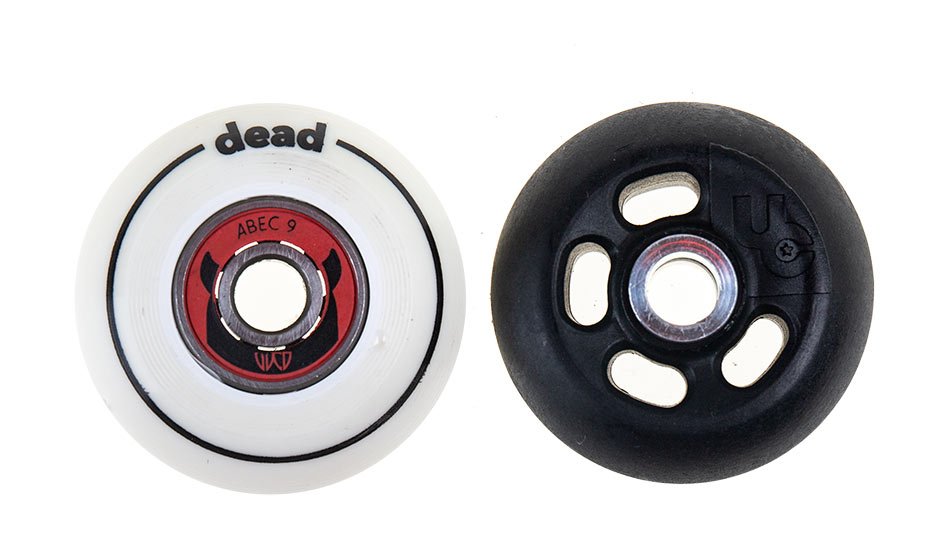
Thus, we strongly recommend grindwheels made of hard urethane with room for standard bearings. Such set of grindwheels can last you for a several pairs of skates and will roll properly, meaning that they won’t cause you to stop suddenly while going over small obstacles and imperfections in the surface. This is important to newcomers to the sport, so if you are just picking up aggressive skating and want to use antirocker setup, get yourself a set of four, proper, urethane grindwheels. Another bonus is that they are as silent as normal wheels, and nothing beats a sound of solid "thud" on landings.
To sum it all up...
There are no universal wheels for everything, so making the right choice is crucial for your enjoyment of skating. Next time you’ll be buying a fresh set of wheels for your skates, spend some time thinking thoroughly about the choice - pick ones that will suit your riding style and above all, the place where you skate most often!
You can find wheels mentioned in the article under liks below:
Keep rolling and good luck dropping those hammers!


